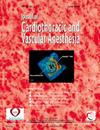Dose-Dependent Changes in Clot Firmness in Thromboelastometry After Administration of Fibrinogen Concentrate: A Retrospective Observational Study
IF 2.1
4区 医学
Q2 ANESTHESIOLOGY
Journal of cardiothoracic and vascular anesthesia
Pub Date : 2025-07-22
DOI:10.1053/j.jvca.2025.07.025
引用次数: 0
Abstract
Introduction
Viscoelastic point-of-care diagnostics are crucial in cardiac surgery. In the FIBTEM assay of rotational thromboelastometry (ROTEM), guidelines suggest target maximum clot firmness values to reduce perioperative bleeding. The fibrinogen doses required to meet these targets remain unclear. This study analyzed the dose-response relationship between fibrinogen concentrate (FC) and clot strength at 5 minutes (A5) and assessed the predictive value of A5 for postoperative hypofibrinogenemia.
Design
Single-center retrospective observational study.
Setting
Tertiary academic cardiac hospital.
Participants
180 cardiac patients operated on between May 31, 2022, and August 31, 2024.
Interventions
Patients underwent 2 intraoperative ROTEM examinations and received coagulation factors.
Measurements and Main Results
Linear regression was used to examin the relationship between the FC dose and A5 changes. Receiver operating characteristic curves assessed the value of A5 in predicting hypofibrinogenemia and bleeding. Weight-based and estimated blood volume–based FC dosing closely correlated with A5 changes. Each 10 mg/kg increase in FC increased A5 by a mean of 1.37 mm (95% confidence interval [CI], 1.12-1.53 mm) for total body weight, 1.20 mm (95% CI, 1.08-1.33 mm) for ideal body weight, and 1.02 mm (95% CI, 0.9-1.13 mm) for lean body weight, as well as 8.857 mm (95% CI, 7.910-9.818 mm) per mg per mL of estimated blood volume. A5 ≤12 mm predicted hypofibrinogenemia (sensitivity, 77%; specificity, 94%). No thresholds predicted excessive blood loss.
Conclusions
Body weight–based fibrinogen dosing allows predictions of the mean changes in A5. Total, ideal, and lean body weights yielded similar correlation coefficients.
给予纤维蛋白原浓缩物后血栓弹性测量中血块硬度的剂量依赖性变化:一项回顾性观察研究。
介绍:粘弹性点护理诊断是至关重要的心脏手术。在旋转血栓弹性测定(ROTEM)的fitem分析中,指南建议以最大凝块硬度值为目标,以减少围手术期出血。达到这些目标所需的纤维蛋白原剂量仍不清楚。本研究分析了纤维蛋白原浓缩物(FC)与5分钟凝块强度(A5)的剂量-反应关系,并评估了A5对术后低纤维蛋白原血症的预测价值。设计:单中心回顾性观察研究。单位:三级心脏专科医院。参与者:在2022年5月31日至2024年8月31日期间接受手术的180名心脏病患者。干预措施:患者进行2次术中ROTEM检查并接受凝血因子治疗。测量结果及主要结果:采用线性回归分析FC剂量与A5变化之间的关系。受试者工作特征曲线评估A5在预测低纤维蛋白原血症和出血中的价值。基于体重和估计血容量的FC剂量与A5变化密切相关。FC每增加10 mg/kg,总体重的A5平均增加1.37 mm(95%可信区间[CI], 1.12-1.53 mm),理想体重的A5平均增加1.20 mm (95% CI, 1.08-1.33 mm),瘦体重的A5平均增加1.02 mm (95% CI, 0.9-1.13 mm),每mg/ mL估计血容量的A5平均增加8.857 mm (95% CI, 7.910-9.818 mm)。A5≤12 mm预测低纤维蛋白原血症(敏感性77%,特异性94%)。没有阈值预测失血过多。结论:基于体重的纤维蛋白原剂量可以预测A5的平均变化。总体重、理想体重和瘦体重产生相似的相关系数。
本文章由计算机程序翻译,如有差异,请以英文原文为准。
求助全文
约1分钟内获得全文
求助全文
来源期刊
CiteScore
4.80
自引率
17.90%
发文量
606
审稿时长
37 days
期刊介绍:
The Journal of Cardiothoracic and Vascular Anesthesia is primarily aimed at anesthesiologists who deal with patients undergoing cardiac, thoracic or vascular surgical procedures. JCVA features a multidisciplinary approach, with contributions from cardiac, vascular and thoracic surgeons, cardiologists, and other related specialists. Emphasis is placed on rapid publication of clinically relevant material.

 求助内容:
求助内容: 应助结果提醒方式:
应助结果提醒方式:


